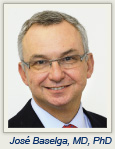Personalized medicine: It’s a phrase that reverberates across all cancer meetings. “Matching the right drug to the right patient” will be accomplished, in the not too distant future, through genomic sequencing of the tumor and targeted, less toxic therapy. This much has been established—or has it?
 The journey has begun, but there are roadblocks that could stall progress, said Gordon Mills, MD, of the Zayed Institute for Personalized Cancer Therapy at The University of Texas MD Anderson Cancer Center, Houston. Dr. Mills was asked to present the challenges to implementation of personalized medicine in a discussion at the 2011 European Multidisciplinary Cancer Congress.1
The journey has begun, but there are roadblocks that could stall progress, said Gordon Mills, MD, of the Zayed Institute for Personalized Cancer Therapy at The University of Texas MD Anderson Cancer Center, Houston. Dr. Mills was asked to present the challenges to implementation of personalized medicine in a discussion at the 2011 European Multidisciplinary Cancer Congress.1
“We are coming closer to having a scientific underpinning for what we want to do but integrating this remains a challenge,” he said. “Can we achieve personalized therapy? Is it even doable?”
For the discussion, Dr. Mills was joined by José Baselga, MD, PhD, Associate Director of the Massachusetts General Hospital Cancer Center, Boston, who provided a more optimistic perspective on personalized medicine.2
‘A Watershed Moment’
 “There is a sea change in the treatment of patients with cancer. This is a watershed moment in cancer history,” Dr. Baselga began. Understanding the genetics of each tumor will change how researchers test new drugs and clinicians use them. The challenge is to establish the technology to support the necessary clinical research.
“There is a sea change in the treatment of patients with cancer. This is a watershed moment in cancer history,” Dr. Baselga began. Understanding the genetics of each tumor will change how researchers test new drugs and clinicians use them. The challenge is to establish the technology to support the necessary clinical research.
Comprehensive genetic characterization of tumors will encompass DNA epigenetics, mutations, and chromosomal alterations; proteomics; and messenger RNA and micro-RNA profiling. It is important, he said, to genotype in real time for known and clinically significant mutations that can be targeted, and then—after testing for drug sensitivity—to monitor serially during treatment (with circulating tumor cells, functional imaging). “We cannot continue to start chemotherapy and wait 2 months for the CT scan to tell us if the patient is responding,” he said.
Need to Study Drugs Earlier, in Smaller Trials
To have a major impact, technologic advances and novel treatments must be applied in early disease, and clinical trials condensed. “Smaller, smarter clinical trials will provide answers,” Dr. Baselga predicted. “We can’t afford to do clinical trials with thousands of patients now.”
For example, an analysis of the Neo-ALTTO study presented at the meeting3 showed that FDG-PET/CT metabolic responders, vs nonresponders, were twice as likely to achieve a pathologic complete response after neoadjuvant dual HER2 blockade. If clinical outcomes prove similar between the 450-patient Neo-ALTTO trial and the 8,000-patient ALTTO adjuvant trial, “we can propose that neoadjuvant studies might answer our [efficacy] questions,” he said.
Success in personalized medicine will also require effective combinations to address the compensatory pathways that form the escape routes for tumors. The recognition of cross-talk between mTOR and the estrogen receptor led to the discovery that everolimus (Afinitor) given with an aromatase inhibitor can reverse the resistance to hormonal therapies (as in the BOLERO-2 study). “Studies of resistance will be key,” he said.
Dr. Baselga concluded that in addition to sophisticated technology platforms, novel trial design, and tolerable drugs that will hit the mark, bringing personalized medicine forward will also require recruiting “the best pool of physician scientists into a culture of teamwork.”
An ‘N of One’ Problem
 Dr. Mills added a sobering note. While personalized medicine is “clearly in our future,” he questioned whether “we are overpromising our patients.”
Dr. Mills added a sobering note. While personalized medicine is “clearly in our future,” he questioned whether “we are overpromising our patients.”
“The biggest problem is the ‘N of one,’” he said, pointing out that small, homogeneous patient groups unified by discreet tumor genetic profiles will turn cancer into “an orphan disease.… Some subgroups will be so small it will be impossible to implement clinical trials with sufficient power,” Dr. Mills noted.
While remarkable responses have been observed in individual patients whose tumors seem matched to the optimal drug, only subpopulations of patients benefit, resistance develops, and their responses are not durable. “We have to figure out how to make durable, combinatorial therapy to improve outcomes,” he said.
Increasing Recognition of Tumor Complexity
As the uniqueness of individual tumors becomes clear, concerns are growing that even combinations of the right drugs will fall short due to intratumoral heterogeneity. Studies have found up to 40% discordance between the primary and recurrent lesions, and discordant cases have significantly worse outcomes. Personalized medicine will require multiple biopsies. As Dr. Baselga noted, the goal is to replace biopsies with molecular imaging and characterization of circulating tumor cells or DNA, but this “remains a dream,” Dr. Mills maintained.
Further, science must be able to distinguish mutations that are drivers, and therefore targetable, from those that are mere passengers. Tumors will need to be sequenced in depth to capture important subclones, he said.
“We are finding hundreds if not thousands of mutations. How will we integrate this information to find drivers that can be targeted for each patient? Not all mutations are created equal. And for the actionable aberrations, we have a limited number of drugs,” he pointed out.
Cost will certainly be an issue. While the price of sequencing is dropping, the cost of handling the sequencing is not.
“The cost of $10,000 for a human genome does not include the costs of bioinformatics analysis of data storage and handling. Indeed, it has been estimated that even the eventual $1,000 genome will cost $100,000 to manage and interpret,” he said, and the cost will rise in parallel with the depth of sequencing demanded.
Fewer than 5% of companies now reimburse for genomic testing. There are also ethical, regulatory, laboratory, and educational issues.
MD Anderson Program
Forging ahead, The University of Texas MD Anderson Cancer Center has begun a research program to deliver on the promise. “We are finding actionable mutations and doing ‘N of one’ clinical trials in an efficient manner to determine which populations could benefit from a particular drug,” Dr. Mills reported.
“We are seeing very exciting results,” he said. For example, they have found high response rates among patients with PI3K mutations treated with PI3K-targeted therapies, especially those with endometrial or ovarian cancer, although the responses are not long-term.
Altogether, however, the initial results in the first 1,000 patients have, in general, been “surprising and disappointing,” he noted. Only about 40% have had aberrations, and only 25% had actionable mutations.
Dr. Mills assumes that patients who are cured of their cancer tend to have low-grade tumors that are “chock full” of actionable targets—they respond to standard treatments. Clinical trials, on the other hand, are more likely filled with patients who have high-grade tumors with p53 mutations “that we don’t know what to do with,” driven by genomic instability, he suggested.
“Thus, while there is incredible excitement about the potential implementation of personalized cancer therapy, it is easy to contend that the spectacular press and excitement is massively overblown,” Dr. Mill maintained. “The number of successes—and in most cases, these are found only in small subpopulations of patients and are transient—are far outnumbered by spectacular failures.”
“There are still many patients who will benefit, but in terms of delivering ‘personalized medicine’ to all patients,” Dr. Mills concluded, “we are way below the desired numbers.” ■
Disclosure: Drs. Mills and Baselga reported no potential conflicts of interest.
References
1. Mills GB: Challenges to impelementation of personalised cancer therapy. 2011 European Multidisciplinary Cancer Congress. Abstract 3. Presented September 24, 2011.
2. Baselga J: Personalised medicine: Are we hunting the Holy Grail? Personalised medicine is the future. 2011 European Multidisciplinary Cancer Congress. Abstract 2. Presented September 24, 2011.
3. Gamez C, Flamen P, Holmes E, et al: FDG-PET/CT for early prediction of response to neoadjuvant lapatinib, trastuzumab and their combination in HER2-positive breast cancer patients: the Neo-ALTTO study results. 2011 European Multidisciplinary Cancer Congress. Abstract 5013. Presented September 24, 2011.

